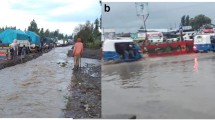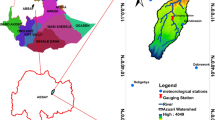Abstract
Watershed hydrology, including the volumes of stream flow is widely considered to be influenced by global climate change. Traditional studies using the (GWLF) model to estimate stream flows have relied on evapotranspiration cover coefficient (Kc) obtained from published references. Other factors, such as future land-use status and evapotranspiration (ET) change, are usually not considered. This study aims to improve on traditional studies by including remote sensing techniques to estimate the Kc, as well as integrating the SEBAL model, the CGCM1 model, and the Markov model to predict land-use and ET changes. The chosen study area was in the north of Taiwan. The processes include land-use classification using hybrid approach and Landsat-5 TM images, a comparison of stream flow simulations using the GWLF model with two Kc values derived from remote sensing and traditional methods, and finally the prediction of future land-use and Kc parameters for assessing the effect of land-use change and ET change. The results indicated that the study area was classified into seven land-use types with 89.09% classification accuracy. The stream flows simulated by two estimated Kcs were different, and the simulated stream flows using the remote sensing approach presented more accurate hydrological characteristics than a traditional approach. In addition, the consideration of land-use change and ET change indeed affected the predicted stream flows under climate change conditions. These results imply that the integration of remote sensing, the SEBAL model, the CGCM1 model, and the Markov model is a feasible scheme to predict future land-use, ET change, and stream flow. Therefore, these models will improve future studies of predictions in water resource management and global environmental change.
Similar content being viewed by others
References
Arnell NW, Reynard NS (1996) The effect of climate change due to global warming on river flow in great Britain. J Hydrol 183:397–424
Austin MB, Belbin L (1981) An analysis of succession along an environmental gradient using data from a lawn. Vegetatio 46:19–30
Baker WL (1989) A review of models of landscape changes. Landsc Ecol 2(2):111–133
Bastiaanssen WGM, Menenti M, Feddes RA, Holtslag AAM (1998) A remote sensing surface energy balance algorithm for land (SEBAL)1: part 1 formulation. J Hydrol 212–213:198–212
Bell EJ (1974) Markov analysis of land use change: an application of stochastic processes to remotely sensed data. Socio-Econ Plann Sci 8:311–316
Bell EJ, Hinojosa RC (1977) Markov analysis of land use change: continuous time and stationary processes. Socio-Econ Plann Sci 11:13–17
Binkley CS (1980) Is succession in hardwood forests a stationary Markov process? For Sci 26:566–570
Bosen JF (1960) A formula for approximation of saturation vapor pressure over water. Mon Weather Rev 88(8):275–276
Bourne LS (1971) Physical adjustment processes and land use succession: a conceptual review and central city example. Econ Geogr 47:1–15
Burnham BO (1973) Markov intertemporal land use simulation model. South J Agric Econ 5:253–258
Cheng CC, Wu CD, Wang SF (2005) Application of Markov and logit models on monitoring landscape changes. Taiwan J Forest Sci 20(1):29–36
Cheng CC, Wu CD, Chuang YC (2007) Influence of land-use changes and climate change on stream flow simulations: a case study of the Jiao-Long watershed. Taiwan J Forest Sci 22(4):483–495
Davis CV, Sorensen KE (1969) Handbook of applied hydraulics. McGraw-Hill, New York, p 1272
Flato GM, Boer GJ, Lee WG, McFarlane NA, Ramsden D, Reader MC, Weaver AJ (2000) The Canadian centre for climate modeling and analysis global coupled model and its Climate. Clim Dyn 16:451–467
Gibson CWD, Guilford TC, Hambler C, Sterling PH (1983) Transition matrix models and succession after release from grazing on Aldabra atoll. Vegetatio 52:151–159
Goodman LA (1968) The analysis of crossclassified data: independence, quasi-independence, and interactions in contingency tables with or without missing entries. J Am Stat Assoc 63:1031–1091
Haith DA, Shoemaker LL (1987) Generalized watershed loading functions for stream flow nutrients. Water Resour Bull 23(3):471–478
Haith DA, Mandel R, Wu RS (1992) Generalized watershed loading functions version 2.0 user’s manual. Department of Agricultural and Biological Engineering, Cornell University, Ithaca, New York, p 61
Hall FG, Strebel DE, Goetz SJ, Woods KD, Botkin DB (1987) Landscape pattern and successional dynamics in the boreal forest. In: Proc. IGARSS ’87 symp, Ann Arbor, Mich., 18–21 May 1987, pp 473–482
Hamon WR (1961) Estimating potential evapotranspiration. In: Proceeding of the american society of civil engineers. Journal of the hydraulics divison 87(HY3), pp 107–120
Hong NM (1997) The impacts of climate change on the management of water resources in the Ta-An River. Master thesis, Department of Bioenvironmental System Engineering, National Taiwan University, p 67
IPCC (2007) Climate change 2007, Working Group III (WG III) mitigation of climate change. http://www.ipcc.ch/ipccreports/ar4-wg3.htm
Laymon C, Quattrochi D, Malek E, Hipps L, Boettinger J, McCurdy G (1998) Remotely-sensed regional-scale evapotranspiration of a semi-arid great basin desert and its relationship to geomorphology, soils, and vegetation. Geomorphology 21:329–349
Li MH, Tung CP, Sui CH, Yang FH (2006) Estimating seasonal basin rainfall using tabu search. Terrestrial, Atmospheric and Oceanic Sciences 17(1):295–316
Lindsay BE, Dunn DL (1979) Land use projections under alternative policies: a transition matrix approach. J Northeast Agric Econ Counc 8(2):87–99
Lippe E, DeSmidt JT, Glenn-Lewin DC (1985) Markov models and succession: a test from a heathland in the Netherlands. J Ecol 73:775–791
Lo CP, Choi J (2004) A hybrid approach to urban land use/cover mapping using Landsat 7 Enhanced Thematic Mapper Plus (ETM+) images. Int J Remote Sens 25(14):2687–2700
Manning M, Nobre C (2001) Climate change 2001: impacts, adaptation, and vulnerability. IPCC Working Group II, UK
Marsden MA (1983) Modeling the effect of wildfire frequency on forest structure and succession in the northern Rocky Mountains. J Environ Manag 16:45–62
Menenti M, Choudhury BJ (1993) Parameterization of land surface evaporation by means of location dependent potential evaporation and surface temperature range. In: Proc. exchange processes at the land surface for a range of space and time scales, vol 212. IAHS Publ, pp 561–568
Morse AT, Tasumi G, Richard A, Willam JK (2000) Application of the SEBAL methodology for estimating consumptive use of water and stream flow depletion in the bear river basin of Idaho through remote sensing. The Raytheon Systems Company-Earth Observation System Data and Information System Project, Waltham, MA, p 107
Muller MR, Middleton K (1994) A Markov model of land-use change dynamics in the Niagara region, Ontario, Canada. Landsc Ecol 9:151–157
Oberg J, Melesse AM (2004) Evapotranspiration changes at the glacial ridge prairie wetland restoration project: a remote sensing perspective. In: Proc of self-sustaining solutions for streams, wetlands and watersheds, ASAE specialty conference, pp 199–206
Pickering NB, Stedinger JR, Haith DA (1988) Weather input for nonpoint source pollution models. J Irrig Drain Eng 114(4):674–690
Rejmanek M, Sasser CE, Gosselink JG (1987) Modeling of vegetation dynamics in the Mississippi River deltaic plain. Vegetatio 69:133–140
Tien WT (2003) The effects of climate change on the land hydrologic cycles in Taiwan. Master thesis, National Central University, Graduate Institute of Hydrological and Oceanic Sciences, Taoyuan, Taiwan, p 105
Tung CP (2001) The impacts of climate change on Tsengwen creek water resources in Taiwan. J Am Water Resour Assoc 37(1):1–10
Tung CP, Haith DA (1995) Global warming effects on New York stream flows. J Water Resour Plan Manage 121(2):216–225
Turner MG (1993) Landscape changes in nine rural counties in Georgia. Photogramm Eng Remote Sensing 56(3):379–386
Wu RS, Haith DA (1993) Land use, climate and water supply. J Water Resour Plan Manage 119(6):685–704
Yu PS, Yang TC, Wu CK (2002) Impact of climate change on water resources in southern Taiwan. J Hydrol 260:161–175
Author information
Authors and Affiliations
Corresponding author
Rights and permissions
About this article
Cite this article
Wu, CD., Cheng, CC., Lo, HC. et al. Application of SEBAL and Markov Models for Future Stream Flow Simulation Through Remote Sensing. Water Resour Manage 24, 3773–3797 (2010). https://doi.org/10.1007/s11269-010-9633-9
Received:
Accepted:
Published:
Issue Date:
DOI: https://doi.org/10.1007/s11269-010-9633-9




